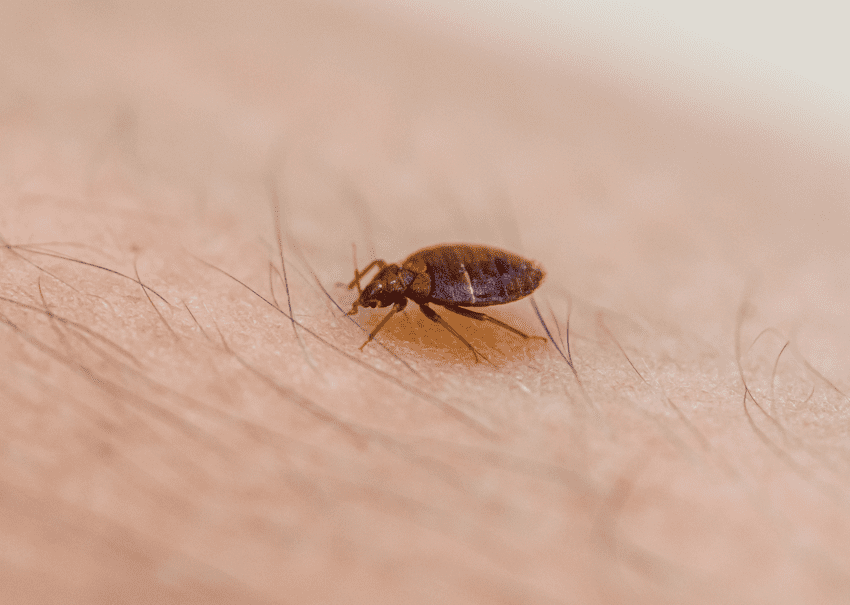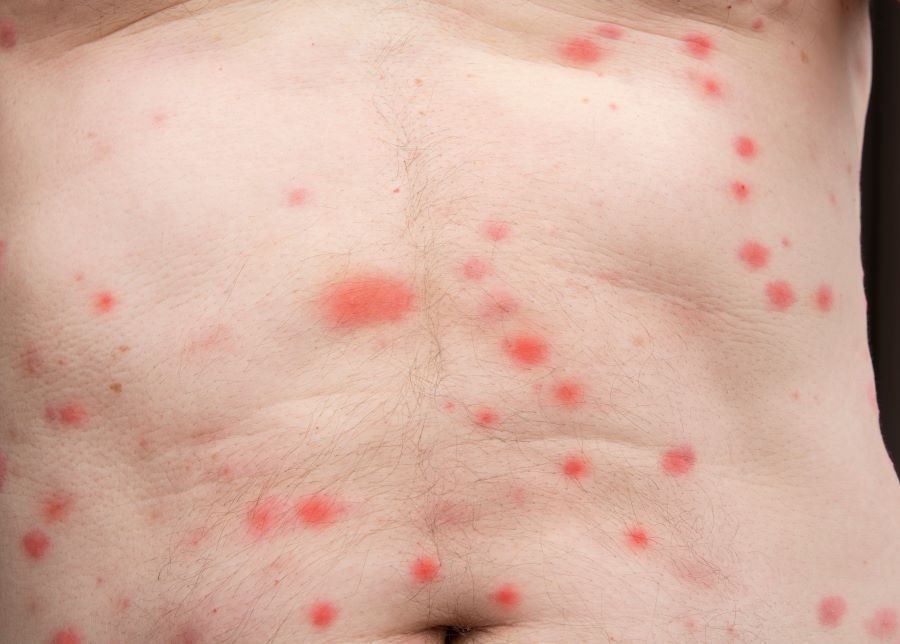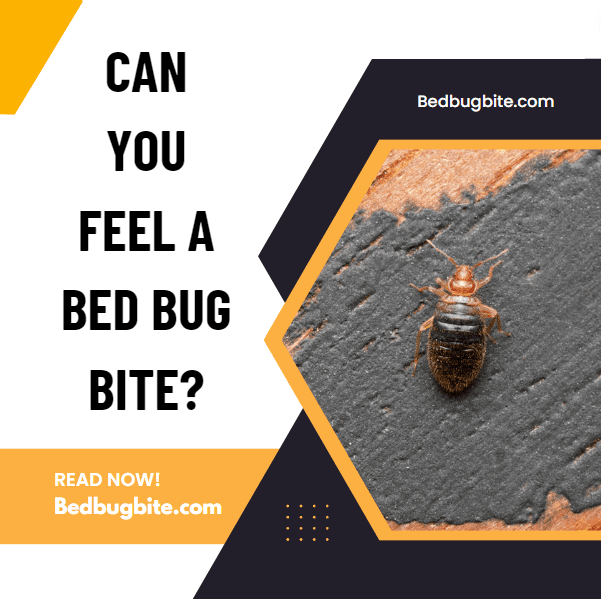Introduction
Welcome to our in-depth exploration of a common concern many face in their homes: bed bug bites. With bed bugs becoming increasingly prevalent across the globe, understanding the nuances of their bites is more important than ever. Bed bugs, tiny nocturnal insects, have made a notorious comeback in our living spaces. Leading to discomfort and distress for many. Our aim here is to shed light on whether one can actually feel a bed bug bite and to demystify the reactions these pests provoke. …Click Here to Read More About Bed Bugs!
Bed bugs are known for their stealthy feeding habits, often biting unsuspecting individuals during the night. The primary question that arises is: Can you truly feel when a bed bug bites you? This question underscores the silent dilemma many face, as these bites can lead to a range of symptoms. From no reaction at all to severe allergic reactions. Understanding bed bug bites is crucial for identifying an infestation early and taking the necessary steps to combat these unwelcome guests.

This post will delve into the nature of bed bug bites, how they differ from other insect bites, and the unique characteristics that may help you identify them. Furthermore, we will discuss the significance of recognizing the signs of bed bug infestations and the effective measures you can take to treat their bites. Join us as we uncover the truth about bed bug bites. Equipped with scientifically-backed information and practical advice to navigate this challenge.
Unveiling the Mystery
For those looking to deepen their understanding of bed bugs and their impact, the Centers for Disease Control and Prevention (CDC) offers extensive resources and guidance on dealing with these pests. This reputable source provides valuable insights into bed bug biology, behavior, and prevention strategies, reinforcing the importance of informed action in managing bed bug issues.
As we embark on this comprehensive guide, our goal is to empower you with the knowledge to detect, prevent, and respond to bed bug bites effectively. Whether you’re currently facing an infestation or seeking to prevent one. Understanding the sensation and implications of bed bug bites is the first step towards ensuring your home remains a comfortable and bed bug-free environment.
What Are Bed Bug Bites?
In the quest to demystify bed bug bites, it’s essential to delve into their basic characteristics. Bed bug bites are often mistaken for other insect bites, making accurate identification a cornerstone of effective response and management. These bites typically appear as small, red, and sometimes itchy bumps on the skin. Often in a line or cluster due to the bed bug’s habit of biting multiple times in close proximity. However, the reactions to these bites can vary significantly from person to person. Leading to a wide array of misconceptions about their severity and appearance.
How Bed Bugs Bite: The Process and Why It’s Often Unnoticed
Bed bugs have a sophisticated feeding process. They use two mouthparts: one injects an anticoagulant along with an anesthetic to ensure the host does not feel the bite and the feeding goes unnoticed. The other mouthpart draws blood. This stealthy approach allows bed bugs to feed undetected, often leaving no immediate sensation. It’s only after the fact, sometimes several days later, that symptoms might appear. Leading to confusion and misattribution of the bites to other causes.
Immediate Reaction: Can You Feel It?
For most individuals, the biting process is imperceptible. The anesthetic property of bed bug saliva plays a crucial role here, numbing the area around the bite and making the act of biting virtually undetectable. Immediate reactions are rare, and when they do occur, they are often mild, with minimal discomfort at the bite site.
Delayed Reactions and Symptoms: What to Look Out for

While the initial bite may go unnoticed, delayed reactions are common and can vary widely. Some individuals may experience no symptoms at all, while others develop itching, red welts, or swelling around the bite sites. In more severe cases, allergic reactions can occur, necessitating medical attention. The variability in reactions is attributed to individual sensitivities to bed bug saliva. Underscoring the complexity of diagnosing bed bug bites solely based on physical symptoms.
Understanding the nuanced nature of bed bug bites and the body’s response is vital in recognizing an infestation and taking timely action. Despite the stealthiness of these pests, being informed about the signs and symptoms of their bites is a powerful tool in the fight against bed bugs. This knowledge not only aids in early detection but also in the effective treatment and management of bites. Minimizing discomfort and the risk of more serious reactions.
The Sensation of Bed Bug Bites
Navigating through the complexity of bed bug bites brings us to a crucial aspect. Understanding the factors that influence the sensation and reaction to these bites. It’s not a one-size-fits-all situation; the range of responses to bed bug bites is wide and varied. This variability is due to several key factors, including individual skin sensitivity and the unique properties of bed bug saliva, which contains compounds designed to make their feeding as stealthy as possible. By exploring these factors, we gain insights into why some people might react strongly to bed bug bites. While others may not notice them at all.
Individual Variability in Skin Sensitivity
The human skin’s response to bed bug bites can vary dramatically from one person to the next. This variability is influenced by numerous factors, including age, immune system strength, and even genetic predisposition. Some individuals may have a higher sensitivity to the proteins in bed bug saliva, leading to more pronounced symptoms. In contrast, others might have a subdued reaction, with little to no visible signs of being bitten.
The Role of Bed Bug Saliva: Anesthetic and Anticoagulant Properties
Bed bug saliva is a sophisticated cocktail of chemicals, including anesthetics and anticoagulants. The anesthetic component ensures the host remains unaware of the biting process by numbing the bite area. Simultaneously, anticoagulants facilitate smooth blood flow, allowing bed bugs to feed efficiently. This combination of substances is what often makes the detection of bed bug bites so challenging in the immediate aftermath of being bitten.
The intricate interplay between individual skin sensitivity and the chemical properties of bed bug saliva is central to understanding why bed bug bites can be such a perplexing issue. It underscores the importance of not relying solely on physical reactions to identify a bed bug infestation. Being aware of these factors can help in better anticipating and recognizing the signs of bed bug bites. Thereby facilitating quicker and more effective responses. Knowledge is power, and in the case of bed bug bites, it’s a crucial component in managing and mitigating their impact.
Factors Influencing the Sensation of Bites
Distinguishing bed bug bites from other insect bites is a critical step in identifying and addressing an infestation. While bed bug bites share similarities with those of mosquitoes, fleas, and ticks, certain features set them apart. Recognizing these differences can prevent misdiagnosis and ensure appropriate measures are taken to eliminate the pests. This section will compare bed bug bites to other common insect bites. Highlighting key distinctions and providing insights into bite patterns and locations, which can be crucial in correctly identifying the source of the bites.
Distinguishing Features of Bed Bug Bites from Mosquito, Flea, and Tick Bites
Mosquito bites are typically isolated, singular bumps on exposed skin, often appearing immediately after being bitten. In contrast, bed bug bites usually occur in a line or cluster and may take days to become noticeable. Flea bites, commonly found around the ankles or legs, resemble those of bed bugs but are more likely to be random in their distribution. Rather than the linear or clustered pattern typical of bed bug bites. Tick bites, on the other hand, can be identified by the presence of the tick itself, burrowed into the skin.
The Significance of Bite Patterns and Locations
The pattern and location of bites are telltale signs of their origin. Bed bug bites often appear on skin exposed during sleep. Such as the arms, neck, and face, and tend to be grouped together in a small area. This pattern reflects the bed bug’s feeding behavior, as they typically make multiple bites in close proximity. Understanding these patterns can provide vital clues in identifying an infestation, guiding individuals towards the correct response and treatment.
Recognizing the unique characteristics of bed bug bites compared to those of other insects is an essential component of effective pest management. By paying attention to the details of bite appearances, patterns, and locations, individuals can more accurately identify the presence of bed bugs and take prompt action. This knowledge not only aids in the early detection of bed bugs but also helps in adopting the most appropriate measures for eradication, ensuring a swift return to a comfortable, pest-free living environment.
Comparing Bed Bug Bites to Other Insect Bites
Identifying a bed bug infestation goes beyond recognizing the bites. While understanding the nuances of bed bug bites is crucial. It’s equally important to be aware of the other signs that indicate the presence of these elusive pests. Bed bugs leave behind a variety of tell-tale indicators in your living environment, which, when detected early, can significantly aid in combating the infestation before it escalates. This section aims to guide you through recognizing these signs. Highlighting where to look and what to find, thus equipping you with the knowledge to act swiftly and effectively.
Signs of Bed Bugs Beyond Bites
Bed bug infestations are often accompanied by more than just bites. Key indicators include small blood spots on sheets or mattresses, which result from crushed bed bugs or bleeding from their bites. Another sign is the presence of dark, tiny spots on bedding or furniture, which are bed bug excrement. Additionally, you might notice shed skins or egg shells in areas where bed bugs hide during the day, providing further evidence of their presence.
Checking Your Living Spaces: Where to Look and What to Find
Bed bugs are adept at hiding, making them difficult to spot without a thorough search. Key areas to inspect include mattress seams, bed frames, headboards, and furniture joints. Bed bugs can also hide in cracks and crevices in walls, floors, and even electrical outlets. Using a flashlight and a credit card to probe these areas can help uncover hidden bed bugs or their signs. Furthermore, a musty odor in your room can be an indicator of a large infestation.
Identifying the signs of a bed bug infestation is a critical step in taking control of the situation. By knowing what to look for and where to look, you can detect an infestation early, significantly improving the chances of successfully eliminating these pests from your home. Vigilance and prompt action upon noticing these signs are essential in preventing the spread of bed bugs, ensuring a clean and comfortable living environment. Armed with this knowledge, you are better prepared to protect your home against the stealthy invasion of bed bugs.
Identifying a Bed Bug Infestation
Once bed bug bites and signs of an infestation are identified, knowing how to respond effectively is paramount. Effective response to bed bug bites involves immediate care to alleviate symptoms and taking decisive steps towards extermination to prevent further issues. This balance between treatment and extermination strategies ensures not just temporary relief but a long-term solution to bed bug problems. In this segment, we’ll explore immediate care options for bed bug bites and compare professional extermination methods with DIY approaches, highlighting the pros and cons of each to help you make informed decisions in tackling a bed bug infestation.
Immediate Care and Treatment Options for Bites
The immediate response to bed bug bites focuses on alleviating itching and preventing infection. Over-the-counter antihistamines or topical creams can be applied to reduce itching and swelling. Additionally, keeping the bite area clean and refraining from scratching are crucial steps to avoid secondary infections. Home remedies, such as applying aloe vera or a baking soda paste, can also offer relief for mild reactions.
Professional vs. DIY Extermination Methods: Pros and Cons
Professional Extermination: Hiring a professional pest control service is often the most effective way to ensure a thorough eradication of bed bugs. Professionals possess the expertise, equipment, and pesticides that are not readily available to the public. This option, while more costly upfront, can save money and time in the long run by preventing repeated infestations.
DIY Extermination: For those considering a DIY approach, there are several methods available, including heat treatment, vacuuming, and using over-the-counter insecticides. While this option can be more economical, it requires a significant amount of time and effort to be effective. Moreover, the risk of improperly applying treatments can lead to persistent infestations or even harm to health and property.
Effective response to bed bug bites and infestations requires a combination of immediate care for symptoms and strategic action to eliminate the pests. While immediate treatments offer temporary relief, addressing the root cause through extermination is crucial for long-term resolution. Whether opting for professional services or undertaking a DIY approach, understanding the pros and cons of each method enables you to choose the most appropriate strategy for your situation. Ultimately, the goal is not just to treat bed bug bites but to create a safe and comfortable environment free from infestation.
Effective Responses to Bed Bug Bites
Preventing future bed bug bites and infestations is key to maintaining a comfortable and safe living environment. Understanding and implementing effective prevention strategies can significantly reduce the risk of bed bug invasions, saving you from the discomfort and inconvenience of dealing with these pests. This section will focus on best practices for bed bug prevention in both homes and while traveling, emphasizing the importance of regular inspections and maintenance in keeping bed bugs at bay. By adopting these preventative measures, you can protect yourself and your home from the threat of bed bugs.
Best Practices for Bed Bug Prevention in Homes
Preventing bed bugs from entering your home requires vigilance and proactive measures. Regularly inspecting and vacuuming your living spaces, including mattresses, furniture, and carpets, can help detect and remove any early signs of bed bugs. Encasing your mattress and box springs with protective covers is an effective way to prevent bed bugs from making a home in your bed. Additionally, reducing clutter in your living spaces can limit bed bug hiding spots, further reducing the risk of infestation.
The Importance of Regular Inspection and Maintenance
Consistent inspection and maintenance of your living environment are crucial in preventing bed bug infestations. This includes checking second-hand furniture for signs of bed bugs before bringing it into your home and sealing cracks and crevices where bed bugs could enter or hide. Regularly washing and heat-drying your bed linens can also kill any bed bugs or eggs that may have found their way into your bedding.
Preventing Bed Bugs While Traveling
Travel is one of the most common ways bed bugs spread. To prevent bringing bed bugs home with you, always inspect hotel rooms or rental accommodations for signs of bed bugs upon arrival. Keep your luggage on a luggage rack rather than on the floor or bed, and consider using a protective luggage cover. Upon returning home, immediately wash all clothing in hot water and vacuum your suitcase to eliminate any hitchhiking bed bugs.
Implementing these preventive measures can significantly lower your risk of encountering bed bug issues. While the prospect of bed bugs can be daunting, taking proactive steps to prevent their presence in your home and during travel can offer peace of mind and protect your living environment. By adhering to these best practices, you can maintain a bed bug-free home and enjoy a comfortable, pest-free life.
Conclusion
In conclusion, understanding and addressing bed bug bites are critical steps in managing and preventing bed bug infestations. This comprehensive guide has explored the nuances of bed bug bites, from the initial sensation (or lack thereof) to distinguishing them from other insect bites, and recognizing the signs of an infestation. We’ve also discussed effective responses to bites, including immediate care and choosing between professional extermination and DIY methods, alongside preventative measures to safeguard your home and prevent future invasions. Armed with this knowledge, you’re now better equipped to detect, treat, and prevent bed bug bites, ensuring a healthier, more comfortable living environment.
Recap of Key Points
- Understanding Bed Bug Bites: Recognizing the varied responses to bed bug bites and the factors influencing them is essential for early detection.
- Identifying and Responding to Infestations: Knowing the signs of bed bugs beyond their bites and selecting the right extermination approach can significantly impact control efforts.
- Preventive Measures: Implementing strategies to avoid bed bugs in your home and while traveling reduces the risk of infestations and promotes long-term protection.
Encouragement for Proactive Measures
Taking proactive steps, including regular inspections and employing preventive practices, is crucial in the fight against bed bugs. By staying vigilant and informed, you can minimize the impact of these pests and maintain a bed bug-free environment.
Seeking Professional Help if Needed
For severe infestations, don’t hesitate to seek professional pest control services. Experts can offer personalized advice and effective treatment options tailored to your specific situation, ensuring the complete eradication of bed bugs from your home.
Additional Resources
For further reading and resources on bed bug prevention, treatment, and control, consider visiting reputable websites such as the Environmental Protection Agency (EPA) and the Centers for Disease Control and Prevention (CDC). These platforms provide valuable information and guidance to help you navigate the challenges of bed bug infestations.
This guide aims to empower you with the knowledge and tools necessary to tackle bed bug issues head-on. Remember, the key to controlling bed bugs lies in education, early detection, and proactive prevention. By applying what you’ve learned, you can protect yourself and your home from the unwelcome discomfort bed bugs bring.




